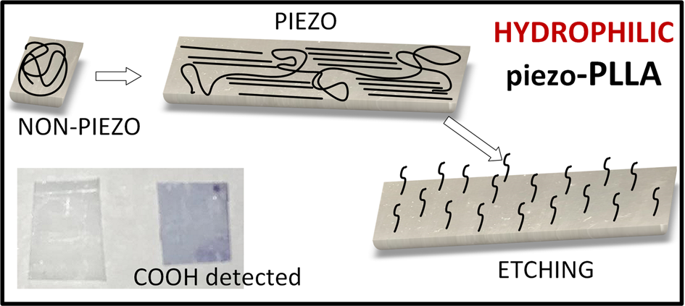Our official English website, www.x-mol.net, welcomes your
feedback! (Note: you will need to create a separate account there.)
Towards hydrophilic piezoelectric poly-L-lactide films: optimal processing, post-heat treatment and alkaline etching
Polymer Journal ( IF 2.3 ) Pub Date : 2019-10-21 , DOI: 10.1038/s41428-019-0281-5 Lea Udovč , Matjaž Spreitzer , Marija Vukomanović
Polymer Journal ( IF 2.3 ) Pub Date : 2019-10-21 , DOI: 10.1038/s41428-019-0281-5 Lea Udovč , Matjaž Spreitzer , Marija Vukomanović

|
Piezoelectric poly-L-lactide (PLLA) films are highly applicable for designing soft electronics in biomedicine. However, due to a lack of reactive side-chain groups, PLLA is characterized by a chemically inert and hydrophobic surface. Although compatible with biological environments, this polymer has very poor interactions with cells. This work is the first report on piezoelectric PLLA films with hydrophilic surfaces. We performed a systematic study that correlated processing parameters (drawing ratio, drawing temperature, drawing rate) with postprocessing steps (annealing and etching) to produce active, hydrophilic, piezoelectric PLLA surfaces. During processing, the optimal drawing ratio, temperature and rate increase the crystallinity and crystallite size and provide chain orientation. Postprocessing annealing and etching afford further improvements in structural properties and optimized surface characteristics. Consequently, the resulting PLLA films possess piezoelectric properties in combination with hydrophilic surfaces and specifically patterned topography. Using this approach, we designed active PLLA films with high potential for strong interactions with cells in further biomedical applications, including exploring the effect of piezoelectricity on cell proliferation. This study provides novel insight into designing synthetic piezoelectric polymers with significantly improved interactions with cells and tissues, which are particularly important for their application in biomedicine. Active, hydrophilic, piezoelectric PLLA surface is formed by correlating processing parameters with etching and annealing as post-processing steps. Optimal design is obtained after uniaxial drawing of films for five times their length at 90 °C with 40 mm min −1 drawing rate and post-processing heat treatment at 140 °C followed by surface alkaline etching. We designed active PLLA film with high potential for intensive interactions with cells, very important for further biomedical applications, including exploring the effect of piezoelectricity on cell proliferation.
中文翻译:

亲水压电聚-L-丙交酯薄膜:优化加工、后热处理和碱性蚀刻
压电聚左旋丙交酯 (PLLA) 薄膜非常适用于设计生物医学中的软电子设备。然而,由于缺乏反应性侧链基团,PLLA 的特点是化学惰性和疏水表面。尽管与生物环境兼容,但这种聚合物与细胞的相互作用非常差。这项工作是关于具有亲水表面的压电 PLLA 薄膜的第一份报告。我们进行了一项系统研究,将加工参数(拉伸比、拉伸温度、拉伸速率)与后处理步骤(退火和蚀刻)相关联,以产生活性、亲水、压电 PLLA 表面。在加工过程中,最佳拉伸比、温度和速率会增加结晶度和微晶尺寸并提供链取向。后处理退火和蚀刻可进一步改善结构特性和优化表面特性。因此,所得的 PLLA 薄膜具有压电特性,结合亲水表面和特殊图案化的形貌。使用这种方法,我们设计了具有高潜力的活性 PLLA 薄膜,在进一步的生物医学应用中与细胞发生强相互作用,包括探索压电对细胞增殖的影响。这项研究为设计具有显着改善的细胞和组织相互作用的合成压电聚合物提供了新的见解,这对其在生物医学中的应用尤为重要。活性、亲水性、压电 PLLA 表面是通过将处理参数与作为后处理步骤的蚀刻和退火相关联而形成的。在 90°C 下以 40 mm min -1 拉伸速率单轴拉伸薄膜五倍长度后获得最佳设计,并在 140°C 下进行后处理热处理,然后进行表面碱性蚀刻。我们设计了具有高潜力的活性 PLLA 薄膜,具有与细胞强烈相互作用的潜力,这对于进一步的生物医学应用非常重要,包括探索压电对细胞增殖的影响。
更新日期:2019-10-21
中文翻译:

亲水压电聚-L-丙交酯薄膜:优化加工、后热处理和碱性蚀刻
压电聚左旋丙交酯 (PLLA) 薄膜非常适用于设计生物医学中的软电子设备。然而,由于缺乏反应性侧链基团,PLLA 的特点是化学惰性和疏水表面。尽管与生物环境兼容,但这种聚合物与细胞的相互作用非常差。这项工作是关于具有亲水表面的压电 PLLA 薄膜的第一份报告。我们进行了一项系统研究,将加工参数(拉伸比、拉伸温度、拉伸速率)与后处理步骤(退火和蚀刻)相关联,以产生活性、亲水、压电 PLLA 表面。在加工过程中,最佳拉伸比、温度和速率会增加结晶度和微晶尺寸并提供链取向。后处理退火和蚀刻可进一步改善结构特性和优化表面特性。因此,所得的 PLLA 薄膜具有压电特性,结合亲水表面和特殊图案化的形貌。使用这种方法,我们设计了具有高潜力的活性 PLLA 薄膜,在进一步的生物医学应用中与细胞发生强相互作用,包括探索压电对细胞增殖的影响。这项研究为设计具有显着改善的细胞和组织相互作用的合成压电聚合物提供了新的见解,这对其在生物医学中的应用尤为重要。活性、亲水性、压电 PLLA 表面是通过将处理参数与作为后处理步骤的蚀刻和退火相关联而形成的。在 90°C 下以 40 mm min -1 拉伸速率单轴拉伸薄膜五倍长度后获得最佳设计,并在 140°C 下进行后处理热处理,然后进行表面碱性蚀刻。我们设计了具有高潜力的活性 PLLA 薄膜,具有与细胞强烈相互作用的潜力,这对于进一步的生物医学应用非常重要,包括探索压电对细胞增殖的影响。









































 京公网安备 11010802027423号
京公网安备 11010802027423号